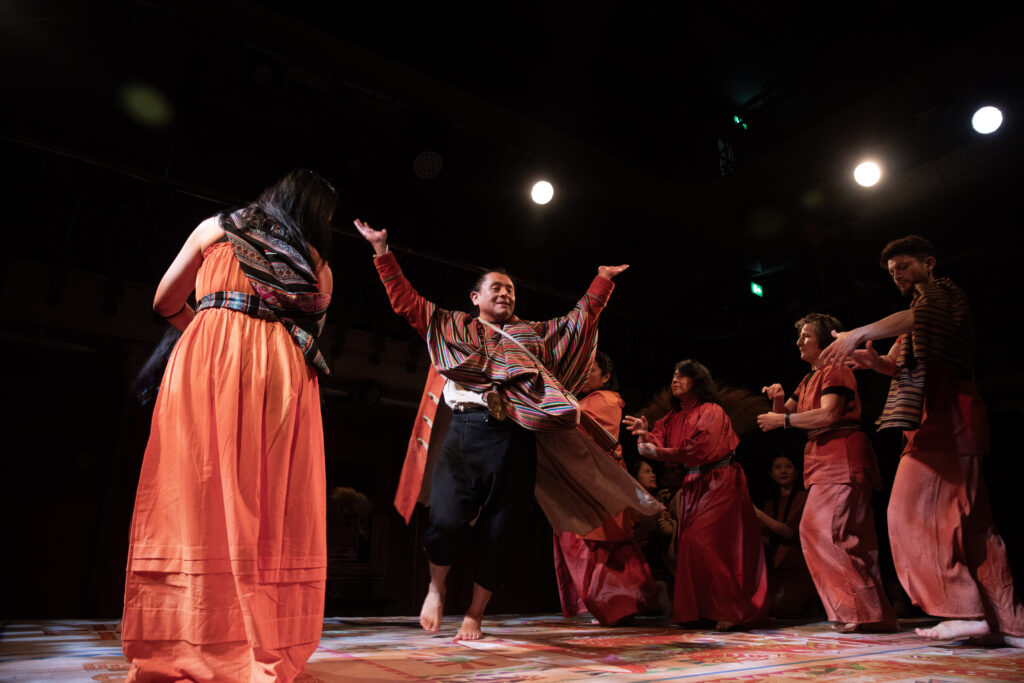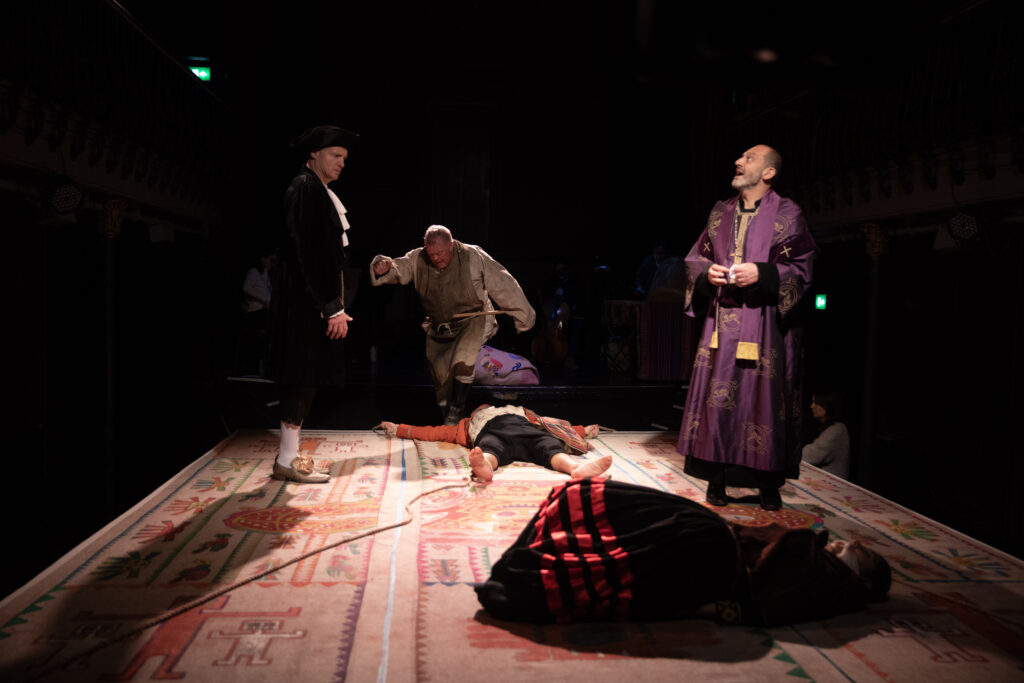The Mouth of the Gods – Hoxton Hall, London
Hoxton Hall comes alive with the sights and sounds of South America in Border Crossing’s The Mouth of the Gods.

The Mouth of the Gods
I was thinking to myself on the way home from The Mouth of the Gods: why does it feel so different? Most productions have a long development time during which various creative processes, research and experimentation occur. Why does this one feel special? I came up with a couple of reasons for this.
Firstly, the richness of the co-creation. The Mouth of the Gods isn’t a straightforward theatrical or musical work. It combines rediscovered music enriched with Western and non-Western instruments, dance, theatre, textile work and embroidery, storytelling, and puppetry. Each of these elements required profound research. Singer Rafael Montero went to the Misión de San Javier in Bolivia where the indigenous Chiquitano opera San Francisco Xavier was composed around 1720. Master embroiderer Bella Lane and choreographer Jessica Mirella Luong drew inspiration from the collections of the British Museum. Putting the unknown indigenous composer’s music back together was a collaboration between a musicologist, musicians, the Horniman Museum and its musical instruments collection, and elders familiar with the almost extinct Chiquitano language and the associated cultural context.
The second reason is the local and global nature of the work. Indigenous South American traditions and the Spanish colonial context transported to London, with local people contributing stitch by stitch or step by step to the final result. What’s an absolute delight to see something like this on my doorstep!

The Traditional and the Contemporary
I’ve already described a lot of what The Mouth of the Gods is, but let me do it properly. It is, according to theatre company Border Crossings, an immersive production taking audiences “on a powerful journey from the oppressive colonial era towards renewal and hope”. Baroque music underpins it. A system of “reductions” enabled (or sometimes forced) Indigenous South American people to live in missionary settlements in exchange for adopting Christianity. This gave many an opportunity to learn Western traditions of music and composition from Jesuit priests. The Indigenous composers didn’t often sign their work, but some of the work survives nonetheless. It’s often an example of syncretism, the synthesising of different religions (in this case indigenous and Christian) which in the South American context made a foreign religion more comprehensible as cultures collided.
The Mouth of the Gods similarly brings traditional South American cultures and beliefs together with what was imposed on it by European colonisation, with Baroque compositions at its core. We start with a blessing, before a scene symbolising the end of pre-colonisation ways of life, using movement and puppetry. A surprising theatrical scene recreates the 1550-51 Valladolid Debate, a moral and theological debate over the conquest of the Americas. A later scene draws parallels with the continued lack of respect for indigenous views and autonomy, as seen in the assassination of activists like Berta Cáceres.
The complexity of cultural exchange is a thread running through The Mouth of the Gods. The compositions of the reductions were simple: just a melody line upon which musicians would elaborate. So although it is music in a Western tradition, it is also music that would have had an indigenous element from the outset. In this production this fusion is embodied by ensemble El Parnaso Hyspano who blend traditional Western and South American instruments. Techniques old, new and cross-cultural similarly combine in the movement and textiles. It’s a story of perseverance and adaptation: what is still here rather than what has been lost.

Staging History, Culture, Art and Activism
It is not an easy thing to do, to fit this much into a 90 minute performance. And frankly not an easy thing to try to communicate to audiences. I thought on the whole, though, that The Mouth of the Gods was successful. There were a few elements I would change: I found it inconsistently surtitled, for instance, and couldn’t quite follow the narrative of all the dance sequences. And I think a synopsis of the scenes and music in the excellent programme would have been a great addition. But it blends many different art forms nicely. There’s even some light relief in the form of the executioner (Tim Hudson) of Túpac Amaru II and his wife Micaela Bastidas (played by Montero and Edith Ramos Guerra), who is more concerned about his working conditions than the morality of the task before him.
It is also a treat to have Peruvian soprano Edith Ramos Guerra as part of the cast. I especially loved hearing her sing in both operatic and traditional styles, showcasing a range of vocal talents. She is regal, and creates an immediate emotional connection with the audience.
A final note on the venue. Hoxton Hall is a wonderfully-intact Victorian music hall. Audiences can sit in the galleries, or can stand around the raised stage. The latter is a more immersive experience, while the former gives a great bird’s-eye view of the textile art. Those in the galleries may struggle to read the surtitles when present, however.
All in all, The Mouth of the Gods is one of the most unique and special experiences I’ve had this year, and that comes from someone who sees a lot of performances. Do see it if you can, you will never have this opportunity again. And best of all, it is free!
Salterton Arts Review’s rating: 4/5
The Mouth of the Gods on until 1 December 2024. More info and tickets here.
Trending
If you see this after your page is loaded completely, leafletJS files are missing.

